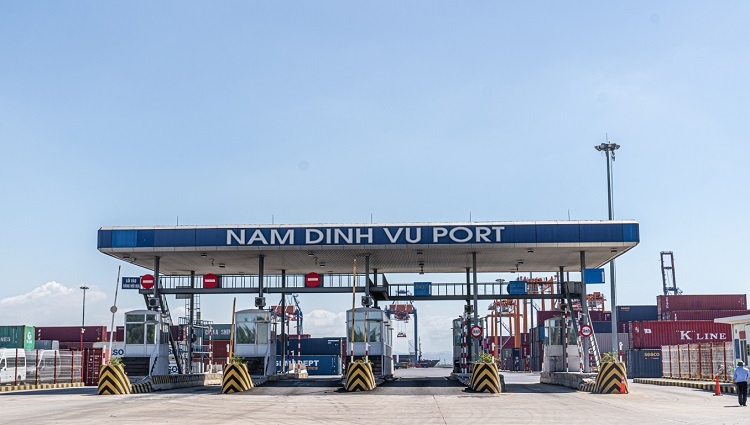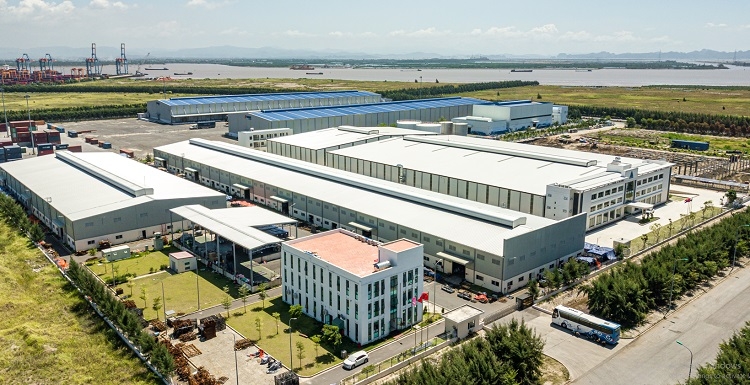Industrial real estate: Narrow internal-external distance
 |
| Nam Dinh Vu Port |
In the first half of 2021, industrial real estate saw steady growth as foreign investors keep increasing local land funds, despite no less than two waves of COVID-19 hitting industrial parks (IPs) in the first half.
These foreign investors include several big names such as multi-functional real estate developer Frasers Property Vietnam which has just announced its first IP project in Vietnam named Binh Duong IP. This IP will bring more than 200,000 square metres of factory space to the market over the next 6-7 years.
ESR Cayman Limited (Hong Kong) and BW Industrial Development JSC have also recently established a joint venture (JV) to develop a modern IP named My Phuoc 4 IP in the north of Ho Chi Minh City, with an area of about 240,000sq.m intended for logistics and light industry.
In a similar move, after setting up a JV for modern logistics real estate for Vietnam last October, SEA Logistic Partners and GLP – the largest warehouse operation investment and management corporation in China – is also actively gathering land for their future plans in Vietnam. By the end of this May, this JV closed deals for five industrial land projects with a total area of nearly 700,000sq.m situated in strategic locations in Ho Chi Minh City, Hanoi, and Haiphong City (Nam Dinh Vu IP – Sao Do Group).
Jeffrey Shen and Stuart Gibson, co-founders and co-CEOs of ESR, commented: “Vietnam's industrial real estate and logistics real estate are in an 'adolescent age'. It is one of the most promising markets in Southeast Asia, benefiting from a range of favourable macroeconomic factors, including high and stable GDP growth, rising income levels, emergence of the middle class, rapid urbanisation, and infrastructure development.”
 |
| Domestic industrial real estate developers need to improve their offerings to attract capital |
Domestic investors not “stuck in place”
Pham Van Nam, an expert in industrial real estate research at the Vietnam Industrial Parks Portal, shared that Vietnam's industrial real estate market is still at a nascent stage.
Specifically, the general level of competence of domestic industrial real estate developers is quite low. With the exception of a few, after 20 years, most industrial real estate developers are of a small scale and limited capabilities, with a lack of vision and strategy.
A number of developers only focus on convenient location in their land funds. However, due to their limited capabilities, implementation work is fragmented, leading to long years of delays and wasting land resources.
 |
| The ready-built factory project in Nam Dinh Vu Industrial Park, developed and operated by BW Industrial has officially started construction. |
Nguyen Hong Van, Hanoi market director at JLL Vietnam shared that for a long time, many domestic investors possessing a large land bank and good location were only interested in developing traditional products, that is, selling/renting land. But as the industrial real estate market reaches a new level of development, ready-built factories are becoming a trend to serve the demands for small- and medium-sized investors, especially satellite companies of multinational corporations looking to shift production. Several investors exploring the market also need to rent factories before making long-term investment decisions.
Meanwhile, Nguyen Thanh Phuong, general director of Sao Do Group, the owner of Nam Dinh Vu IP in Haiphong city said: "Currently, the traditional warehouse system in Vietnam is quite messy, operating at a suboptimal level. Besides that, there is a shortage of international-standard warehouses that can meet the stringent requirements of large manufacturers, while products have not been tailored to the needs of investors.”
According to Phuong, in order to close the gap with foreign investors, domestic ones need to design and "pack" products that are suitable for tenants. In particular, the development of ready-built factories is indispensable in this period.
In fact, Sao Do Group has been cooperating with a professional corporation specialised in the development and operation of ready-built factories named BW to set up this product line at Nam Dinh Vu IP.
“Moreover, with the aim of better serving investors, from the very beginning, we had oriented Nam Dinh Vu as an IP to have an advantage of a seaport," Phuong added. "Therefore, we reserved 200 hectares to expand the seaport and logistics subzone. This area currently consists of seven container and general cargo berths, bonded warehouse and logistics facilities with infrastructure following modern and synchronous standards, all of which are receiving continuing investment."
“Along with direct and indirect investment arriving through mergers and acquisitions, if domestic investors do not improve themselves, their products, and their management capabilities, they will not receive quality secondary investors. Meanwhile, the government and localities are growing more careful in screening foreign investment inflows. There is always a risk of losing market share to foreign investors,” Phuong explained.
Industrial real estate is a golden opportunity now, but it is not always profitable, especially as more enterprises participate in the market, increasing competition. Not only foreign investors also domestic investors shall face this competition.
What the stars mean:
★ Poor ★ ★ Promising ★★★ Good ★★★★ Very good ★★★★★ Exceptional
Related Contents
Latest News
More News
- Haiphong breaks ground on landmark industrial park and LNG power plant (September 28, 2025 | 09:00)
- DEEP C partners with Signify to develop green lighting in industrial zones (August 27, 2025 | 11:01)
- Nam Dinh Vu Industrial Park taps new free trade zone to attract high-quality investment (July 29, 2025 | 14:41)
- Haiphong attracts $15.6 billion in investment (July 16, 2025 | 13:49)
- KinderWorld opens Singapore International School in Haiphong (May 13, 2025 | 14:20)
- Red Flamboyant Festival connecting milestones with ambition (May 13, 2025 | 10:08)
- Haiphong restates its goals with solid fundamentals (May 13, 2025 | 09:57)
- Heroic Haiphong stands tall (May 13, 2025 | 09:38)
- Haiphong’s thrust to go green and digital (May 13, 2025 | 08:00)
- Haiphong private sector emerges as key engine of economic growth (April 21, 2025 | 11:44)

 Tag:
Tag:





















 Mobile Version
Mobile Version